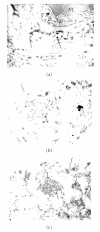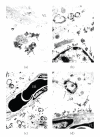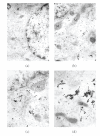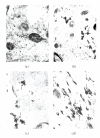The GRK2 Overexpression Is a Primary Hallmark of Mitochondrial Lesions during Early Alzheimer Disease
- PMID: 20204079
- PMCID: PMC2832107
- DOI: 10.1155/2009/327360
The GRK2 Overexpression Is a Primary Hallmark of Mitochondrial Lesions during Early Alzheimer Disease
Abstract
Increasing evidence points to vascular damage as an early contributor to the development of two leading causes of age-associated dementia, namely Alzheimer disease (AD) and AD-like pathology such as stroke. This review focuses on the role of G protein-coupled receptor kinases (GRKs) as they relate to dementia and how the cardio and cerebrovasculature is involved in AD pathogenesis. The exploration of GRKs in AD pathogenesis may help bridge gaps in our understanding of the heart-brain connection in relation to neurovisceral damage and vascular complications of AD. The a priori basis for this inquiry stems from the fact that kinases of this family regulate numerous receptor functions in the brain, myocardium and elsewhere. The aim of this review is to discuss the finding of GRK2 overexpression in the context of early AD pathogenesis. Also, we consider the consequences for this overexpression as a loss of G-protein coupled receptor (GPCR) regulation, as well as suggest a potential role for GPCRs and GRKs in a unifying theory of AD pathogenesis through the cerebrovasculature. Finally, we synthesize this newer information in an attempt to put it into context with GRKs as regulators of cellular function, which makes these proteins potential diagnostic and therapeutic targets for future pharmacological intervention.
Figures






Similar articles
-
Insights into cerebrovascular complications and Alzheimer disease through the selective loss of GRK2 regulation.J Cell Mol Med. 2009 May;13(5):853-65. doi: 10.1111/j.1582-4934.2008.00512.x. Epub 2008 Oct 6. J Cell Mol Med. 2009. PMID: 19292735 Free PMC article. Review.
-
Overexpression of GRK2 in Alzheimer disease and in a chronic hypoperfusion rat model is an early marker of brain mitochondrial lesions.Neurotox Res. 2006 Aug;10(1):43-56. doi: 10.1007/BF03033333. Neurotox Res. 2006. PMID: 17000469
-
Non-visual GRKs: are we seeing the whole picture?Trends Pharmacol Sci. 2003 Dec;24(12):626-33. doi: 10.1016/j.tips.2003.10.003. Trends Pharmacol Sci. 2003. PMID: 14654303 Review.
-
Chapter Three - Ubiquitination and Protein Turnover of G-Protein-Coupled Receptor Kinases in GPCR Signaling and Cellular Regulation.Prog Mol Biol Transl Sci. 2016;141:85-140. doi: 10.1016/bs.pmbts.2016.04.002. Epub 2016 May 7. Prog Mol Biol Transl Sci. 2016. PMID: 27378756 Review.
-
Vascular-targeted overexpression of G protein-coupled receptor kinase-2 in transgenic mice attenuates beta-adrenergic receptor signaling and increases resting blood pressure.Mol Pharmacol. 2002 Apr;61(4):749-58. doi: 10.1124/mol.61.4.749. Mol Pharmacol. 2002. PMID: 11901213
Cited by
-
The evolving impact of g protein-coupled receptor kinases in cardiac health and disease.Physiol Rev. 2015 Apr;95(2):377-404. doi: 10.1152/physrev.00015.2014. Physiol Rev. 2015. PMID: 25834229 Free PMC article. Review.
-
Uncovering conserved networks and global conformational changes in G protein-coupled receptor kinases.Comput Struct Biotechnol J. 2024 Sep 28;23:3445-3453. doi: 10.1016/j.csbj.2024.09.014. eCollection 2024 Dec. Comput Struct Biotechnol J. 2024. PMID: 39403406 Free PMC article.
-
G protein-coupled receptor kinase 2 modifies the ability of Caenorhabditis elegans to survive oxidative stress.Cell Stress Chaperones. 2021 Jan;26(1):187-197. doi: 10.1007/s12192-020-01168-z. Epub 2020 Oct 16. Cell Stress Chaperones. 2021. PMID: 33064264 Free PMC article.
-
G-protein-coupled receptor kinases in inflammation and disease.Genes Immun. 2015 Sep;16(6):367-77. doi: 10.1038/gene.2015.26. Epub 2015 Jul 30. Genes Immun. 2015. PMID: 26226012 Free PMC article. Review.
-
Designer Approaches for G Protein-Coupled Receptor Modulation for Cardiovascular Disease.JACC Basic Transl Sci. 2018 Aug 28;3(4):550-562. doi: 10.1016/j.jacbts.2017.12.002. eCollection 2018 Aug. JACC Basic Transl Sci. 2018. PMID: 30175279 Free PMC article. Review.
References
-
- Iacovelli L, Franchetti R, Grisolia D, De Blasi A. Selective regulation of G protein-coupled receptor-mediated signaling by G protein-coupled receptor kinase 2 in FRTL-5 cells: analysis of thyrotropin, α 1B-adrenergic, and A1 adenosine receptor-mediated responses. Molecular Pharmacology. 1999;56(2):316–324. - PubMed
-
- Lodowski DT, Pitcher JA, Capel WD, Lefkowitz RJ, Tesmer JJG. Keeping G proteins at bay: a complex between G protein-coupled receptor kinase 2 and Gβ γ . Science. 2003;300(5623):1256–1262. - PubMed
-
- Carman CV, Lisanti MP, Benovic JL. Regulation of G protein-coupled receptor kinases by caveolin. The Journal of Biological Chemistry. 1999;274(13):8858–8864. - PubMed
-
- Aliev G, Seyidova D, Neal ML, et al. Atherosclerotic lesions and mitochondria DNA deletions in brain microvessels as a central target for the development of human AD and AD-like pathology in aged transgenic mice. Annals of the New York Academy of Sciences. 2002;977:45–64. - PubMed
-
- Heininger K. A unifying hypothesis of Alzheimer’s disease. III. Risk factors. Human Psychopharmacology. 2000;15(1):1–70. - PubMed
LinkOut - more resources
Full Text Sources

